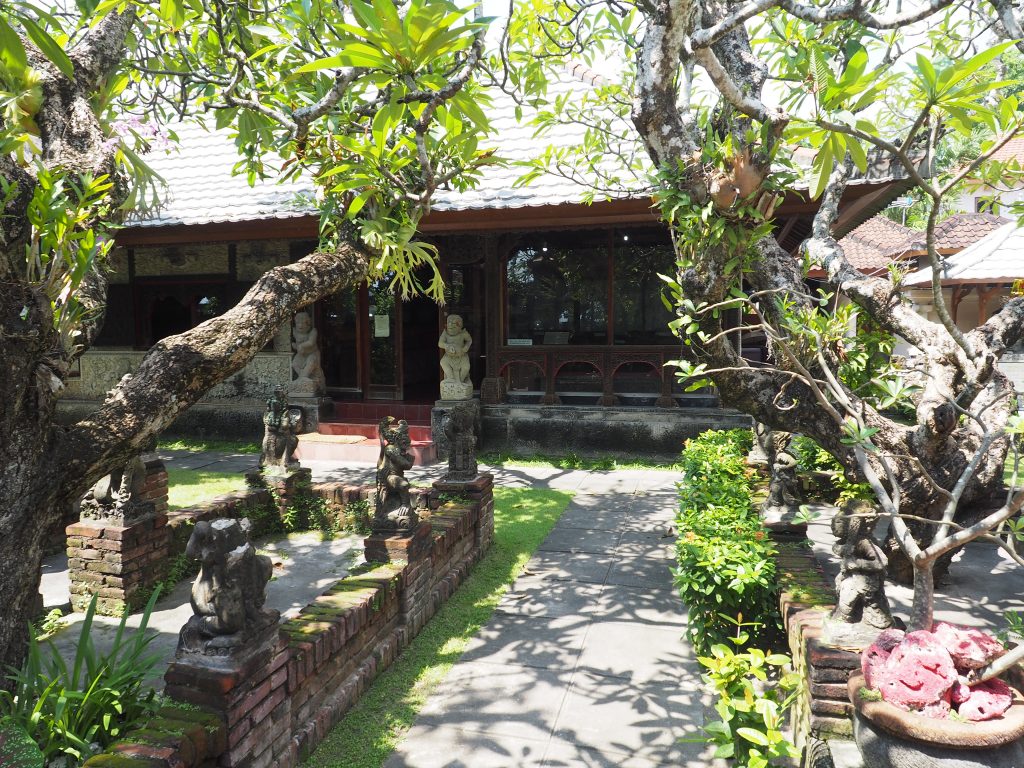Belgian painter Adrien-Jean Le Mayeur (1880-1958) spent the last 25 years of his life in Sanur on the island of Bali. He had a house built right next to the Sindhu beach in 1933. This original house still stands here until today. It is great that it is preserved and that it can be visited as a museum. I stroll leisurely on a pavement next to the beach one early morning with the aim to find his house. You cannot miss it, because its entrance gate catches your eyes and you are there. This type of gate is candi bentar in Balinese. This is how it looks:

I walk through candi bentar and I see the pathway, decorated with statues, leading to the house. Before buying the ticket I am warned by the man at the office that electricity is not functioning today and that there would be no lit exhibits for me should I enter. I am so enthusiastic about visiting this museum that I prefer not to wait another day and I pay the entrance fee and this is how the way toward the house itself looks like. enter. And it is good so, I find the house more authentic. Le Mayeur had his paintins not lit by special lights when he lived here…

The house looks pretty, lavishly decorated and it is Balinese style architecture. I am standing in front of the entrance and I decide to remove my shoes and go in barefoot.

I enter and as the first room is surrounded by huge glass windows, I do not miss any additional light. And it is even better so, I find the house more authentic. Le Mayeur had his paintins not lit by special lights when he lived here…

Both architecture and materials of this house are typical Balinese. The structure is perfectly suitable for tropical climate – ingeniously designed and constructed of wood – local material. There are always gaps between the roof and the walls, enabling ventilation at all times. Other local materials used include bamboo and grass. Special grass used for roof is called “alang-alang” in Indonesian = Imperata cylindrica. Even walls are partially of grass.

Following his marriage in 1935, Le Mayeur had the house redecorated and embelished and thus it became a beautiful residence for him and his new young Balinese wife Ni Pollock. As a visitor I can see the living room, art studio where Le Mayeur had worked, bedroom where Ni Pollock continued to sleep also following her husband´s death in Belgium due to ear cancer. There is a beautifully carved gilded corner cabinet inside which valuables used to be stored in the past, in the corner, however, the bed is not preserved until today.
Spacious bathroom used to be in adjoining room and it even had a door oriented to the back yard, and just a few steps from it there is the well until today. Bath tub had been removed and there are just Le Mayeurs paintings exhibited there. Also dressing room can be visited. Works of art by Le Mayeur are exhibited everywhere, some are originals but many are reproductions only.
I am a layman as far as paintings and works of art are concerned. But never mind the reproductions, I just concentrate on thorough study of the originals. He painted many aquarellles on grass matts with his typical style but I was especially impressed by his oil on canvas paintings. The exhibition is accompanied by many photos depicting Le Mayeur and Ni Pollok. She was also his muse, for this reason she stood as a model for many of his paintings.






